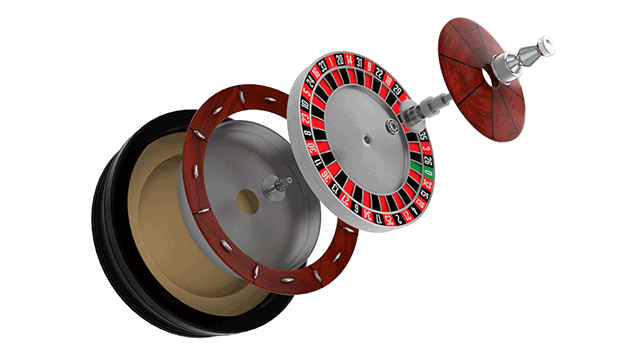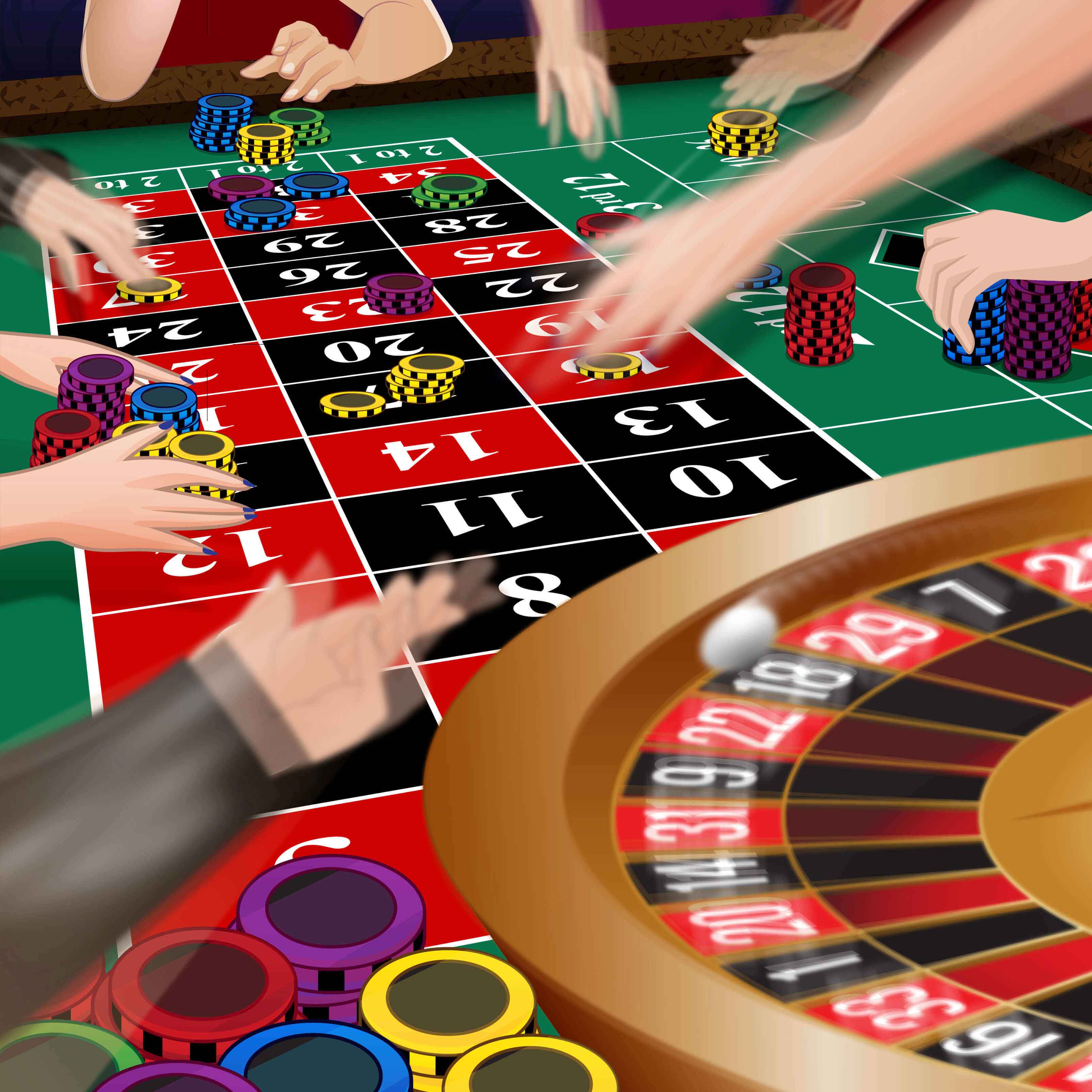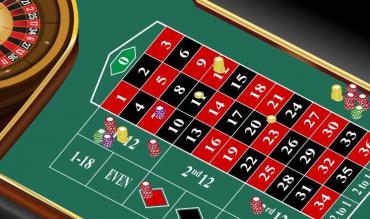Roulette is a game of strategy, and it's all about the numbers; individual numbers, high numbers, low numbers, red numbers, black numbers, odd numbers, even numbers, and dozens of numbers. There are numbers and combinations of numbers that make roulette players’ hearts flutter with excitement. Will my number(s) come in? Or will my numbers disappoint me?
Maybe the biggest hoped for number answers the following question: How much money can I win? Winnings constitute numbers too. Indeed, money might be the essence of all the numbers.
Of course, most offline and online casino games rely on numbers but some are festooned with them and just such a game is roulette. Another such game is craps.
Roulette is an old game too, probably going back to the 16th century to Blaise Pascal’s attempt to create a perpetual motion machine; and perhaps this game goes back even further than that. It is said that Roman soldiers played games by spinning their shields and winning and losing on the outcomes.
[Please note: Why are casino players so obsessed with games composed of numbers? Is it that in reality we always use numbers to figure out where and how we are walking, running, swimming, sailing, driving a car, flying a plane, throwing a baseball, passing a football, shooting a basketball, checking the price of food, entertainment and the expense of an engagement ring? We might not know these activities all boil down to the use of numbers but they certainly do. We are all mathematicians whether we know it or not.]

PLAYING THE NUMBERS
So how should we play the numbers of roulette? First and foremost, we must remember that the game has an edge for the house. On the American double-zero wheel the edge is 5.26 percent, with two exceptions. On the European single-zero wheel, the edge is 2.7 percent, with one exception. The American wheel has 38 numbers; the European wheel has 37 numbers. The payout for a single inside number is 35-to-1 on both wheels.
[Please note: The edge is simple to determine: Divide 38 into 2 and you get .0526 which becomes a house edge of 5.26 percent in the American game. Divide 37 into 1 and you get .0270 which becomes a house edge of 2.7 percent in the European game. Why 2 and 1? Because the house keeps two units for a player win in the American game and one unit of a win in the European game.]
In the following, I will assume that we know what the edges are at both games and I will only mention those edges that differ from the norm.
INSIDE SINGLE NUMBER BETS
You place your chips directly on an individual number or numbers. The payout is 35 to one.
Pros: Because the payout is 35 to one and a win gets those juices flowing, many players prefer this style of betting. If you are lucky enough to make a hit early, the roulette wheel seems like an easy game to beat.
Cons: The pattern of wins and losses is similar to that of a slot machine, although worse, since you only have a one in 37 or a one in 38 chance to come up with a victory. You can experience long periods of losing streaks. That is not much fun. Slot machines actually hit more often even though their percentage edge is usually greater than the one at roulette.
INSIDE SPLIT BETS
You place your chip(s) on the line between two numbers. If either one hits you win 17 to one.
Pros: With one bet you can cover two numbers increasing your chances to win but not increasing or decreasing the house edge. This applies to all inside combination bets. More numbers covered by a single bet, the better a win on that spin.
Cons: The house edge does not change at all on this bet but your chances of winning do go up. Again, the player can have long losing streaks by betting on the splits. Be careful that other bettors do not accidentally push your bet onto a single number.

INSIDE WAGERS:
STREET BETS
You place your bet on the outside line of the three numbers you wish to win. The payout is 11 to one.
Pros: One bet, three numbers covered. Yes, this can reduce losing streaks.
Cons: By placing your bet on an outside line you might find that other players accidentally push your chip(s) away from this outside line. Be aware of this as it does happen at times. You might want to wait to put your bet out so other players are finished with their bets.
SQUARE BETS
This is a four-number bet. You place your bet on the middle area of four boxes so you have two boxes on top of the bet and two boxes underneath the bet. In short, the lines intersect in the middle of the bet. The payout is eight to one.
Pros: Easy bet to notice. Losing streaks continue to be reduced.
Cons: Big problem is once again someone knocking your chip(s) off the bet since many players might want to bet any one of those numbers straight up.
THE MONSTER MASHER OR THE BEAST BET
This five-number bet is only found on the American double-zero wheel and covers the 0, 00, 1, 2 and 3 numbers. It has the highest house edge at roulette of any wager; it comes in at 7.89 percent. Absolutely a total waste of your money! Avoid it.
THE SIXER BET
This is a six-number bet that is placed on the outside line that splits three numbers from three numbers. The payout is five to one.
Pros: Again, with a single bet you can cover six inside numbers. The reduction in losing streaks is the best for this style of inside betting.
Cons: There is a tendency on the part of some players who bet the six numbers to want to cover ever more numbers on the inside and that can create a somewhat frenetic individual prone to losing streaks.
[Please note: Some players want to cover even more inside numbers but not by making individual single bets, so they will put two or more of the above inside combination bets on the layout. You will not see this very often but it is something to be aware of as these bets can be pushed around quite a lot and players don’t want their bets pushed off that layout area.]
OUTSIDE PROPOSITION BETS
You will find all the outside proposition bets ringing the roulette numbers. All of them give you a greater chance of winning than any of the above inside bets. Some are almost 50-50, as in 18 wins and 20 losses on the double-zero wheel and 18 wins and 19 losses on the single-zero wheel. The others are up to a dozen numbers and you can, if you want, bet up to 24 numbers by betting two of these particular propositions.
THE DOZENS BETS
If you look at the layout you will note that numbers 1 through 12; 13 through 24 and 25 through 36 will each form a “boxed” set. These boxes are called the First Dozen, the Second Dozen and the Third Dozen. There is a betting area under each of these dozens for a player to place his or her wagers. The payout on the Dozens bet is two to one. The zero or zeros do not count as part of the Dozens bets.
Pros: Betting a dozen numbers with one bet usually reduces fluctuation and long losing streaks experienced with inside betting. If you bet two of the dozens you get 24 numbers out of 37 and 38 numbers on the respective games.
Cons: Giving yourself so many numbers may at first seem great but keep in mind the more you bet the more money the house edge works on. You will win more often on these bets but you will also lose more money over time.
COLUMN BETS
There is another type of “dozen bet” that is not boxed but is in a lengthwise line on the layout. This bet is called a Column bet and goes from 1 through 34; 2 through 35 and 3 through 36. These numbers are not in numerical order. The betting is done at the bottom of the column and the payout for a winning wager is two to one. The zero or zeros do not count as part of the Column bets.
Pros and cons for the Columns bets are the same as for the above Dozens bets.
HIGH OR LOW BETS
You can bet High numbers which are 19 through 36 or the Low numbers which are 1 through 18. The zero or zeros do not count as either high or low. The payout is one to one.
Pros: You have 18 chances to win and 20 chances to lose on the American double-zero wheel and 18 chances to win and 19 chances to lose on the European single-zero wheel. The pattern of play is rather close as truly long losing streaks are relatively rare.
Cons: The house edge does not change because you have so many possible winners; just the pattern of wins and losses changes.
RED OR BLACK BETS
With the exception of the green zero(s), the numbers at roulette are either red or black. You can bet on either color and the payout for a winning bet is one to one.
The pros and cons are the same as for the High and Low bets.
ODD OR EVEN BETS
Again, with the exception of the green zero(s), numbers at roulette are either odd or even. You can bet either proposition. The payout is one to one.
[Please note: In roulette your initial bet is not part of payout as it is in slots. If a slot pays 10 coins on a line, one or more of those coins will be the actual bet itself. When a roulette bet wins, you keep the original bet and are paid the full amount. So a 10 to one win is actually 10 and your original bet is returned.]
SURRENDER AND EN PRISON
Some casinos around the world offer players the opportunity to reduce the house edge at roulette in half. Instead of bucking a 5.26 percent house edge against the double-zero wheel or a 2.70 percent house edge on the single-zero wheel, you face a 2.63 percent edge or a 1.35 percent edge respectively.
In a game with surrender the live casino dealer will scoop up only half your bet when 0 or 00 hits on the High/Low, Red/Black or Odd/Even. Thus, the house edge drops to 2.63 percent on the double-zero wheels and 1.35 percent on the single-zero wheels.
A 1.35 percent house edge is one of the lowest in the casino.
PUT ME EN PRISON
En prison also reduces the house edge on those outside even-money bets in half. This unique roulette rule is found on some of the single-zero roulette games. It is simple; if the zero hits your bet is locked up until the next spin of the wheel. You will either win or lose that spin.
[Please note: You can bet the same amount for the same length of time on these outside bets with surrender or en prison and reduce your expected losses in half. Or, two, you can double your bet figuring that your wins will be more when you get hot. Or, three, you can employ an even-money roulette betting system, some of which I have written about in other articles. So what is the best bet to use? In my opinion, it is that first one!]
DANGER AWAITS
One danger certainly faces players when they are playing those even-money proposition bets and that is falling into the trap of thinking that trends will dominate and be predictable. “Red has hit six times? It must be hot! No, no, it is about to get cold!”
Neither is true. You can structure your betting “system” however you like but do not lull yourself into a state of belief. Land-based and online roulette are random and the results are random no matter what they seem to be in the short run.
| American Roulette Bets | Payout | Odds |
|---|---|---|
| Even | 1:1 | 46.37% |
| Odd | 1:1 | 46.37% |
| Red | 1:1 | 46.37% |
| Black | 1:1 | 46.37% |
| 1-18 | 1:1 | 46.37% |
| 19-36 | 1:1 | 46.37% |
| 1-12 | 2:1 | 31.58% |
| 13-24 | 2:1 | 31.58% |
| 25-36 | 2:1 | 31.58% |
| Single Number | 35:1 | 2.63% |
| Combination of 2 Numbers | 17:1 | 5.26% |
| Combination of 3 Numbers | 11:1 | 7.89% |
| Combination of 4 Numbers | 8:1 | 10.53% |
| Combination of 6 Numbers | 5:1 | 15.79% |
| Combination of 0, 00, 1, 2, 3 | 6:1 | 13.16% |
| European Roulette Bets | Payout | Odds |
|---|---|---|
| Even | 1:1 | 48.6% |
| Odd | 1:1 | 48.6% |
| Red | 1:1 | 48.6% |
| Black | 1:1 | 48.6% |
| 1-18 | 1:1 | 48.6% |
| 19-36 | 1:1 | 48.6% |
| 1-12 | 2:1 | 32.4% |
| 13-24 | 2:1 | 32.4% |
| 25-36 | 2:1 | 32.4% |
| Single Number | 35:1 | 2.7% |
| Combination of 2 Numbers | 17:1 | 5.4% |
| Combination of 3 Numbers | 11:1 | 8.1% |
| Combination of 4 Numbers | 8:1 | 10.8% |
| Combination of 6 Numbers | 5:1 | 16.2% |
All the best in and out of the casinos!


